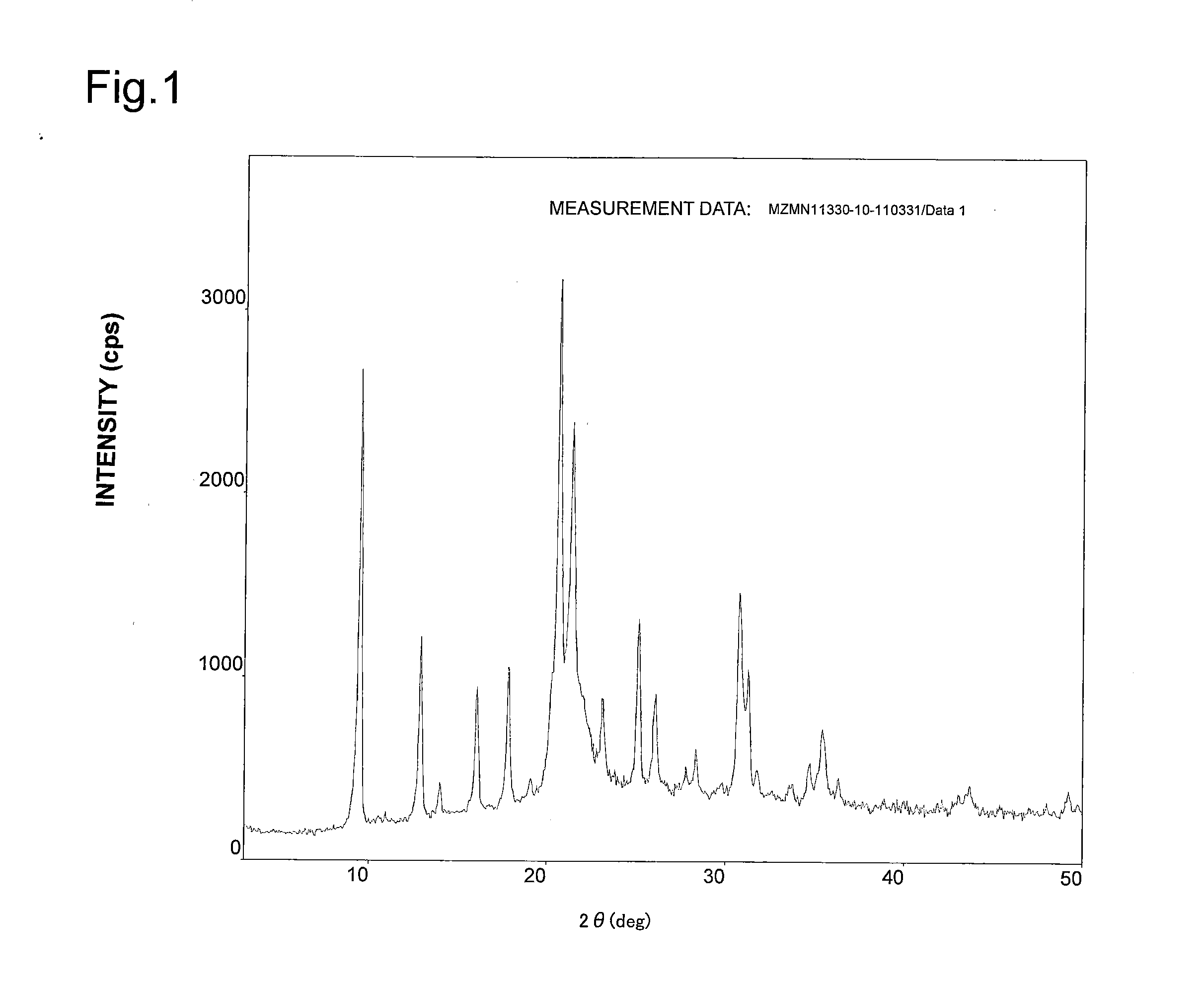Catalyst for nitrogen oxide removal
a technology of nitrogen oxide and catalyst, which is applied in the direction of physical/chemical process catalyst, dispersed particle separation, separation process, etc., can solve the problems of not being able to clean especially mobile units, e.g., automobiles, and achieve excellent nitrogen oxide removal performance and maintenance, and simple efficient production
- Summary
- Abstract
- Description
- Claims
- Application Information
AI Technical Summary
Benefits of technology
Problems solved by technology
Method used
Image
Examples
example 1
[0271]After 80.8 g of 85% phosphoric acid and 68 g of pseudo-boehmite (containing 25% of water, produced by Sasol) are added to 253 g of water gradually, agitation was performed. This was specified to be Liquid A. Separately from preparation of Liquid A, a mixed liquid of 18 g of fumed silica (AEROSIL 200, produced by NIPPON AEROSIL CO., LTD.), 43.5 g of morpholine, 55.7 g of triethylamine, and 253 g of water was prepared. This was added to Liquid A gradually, and agitation was performed for 3 hours, so as to obtain an aqueous gel. The aqueous gel was charged into a 1-L stainless steel autoclave including a fluororesin internal cylinder, the temperature was raised from 30° C. to 190° C. linearly at a temperature raising rate of 16° C. / hour while agitation was performed, and a reaction was induced at a maximum ultimate temperature of 190° C. for 50 hours. In the process of raising temperature to the maximum ultimate temperature, the residence time in the range of 80° C. to 120° C. wa...
example 2
[0277]After 10 g of silica sol (SNOWTEX O, produced by NISSAN CHEMICAL INDUSTRIES, LTD., aggregate sol having a particle diameter of 10-20 nm) was diluted with 20 g of water, 1.8 g of copper (II) acetate-hydrate (produced by KISHIDA CHEMICAL Co., Ltd.) was added so as to dissolve. Subsequently, a water slurry (solid concentration 43 percent by weight) was prepared by adding 8 g of titanium oxide powder (AW-200 produced by Teikoku Kagaku Sangyo K.K.) and 10 g of zeolite described in Example 1, and further performing agitation. The resulting water slurry was sprayed on a metal plate at 170° C. so as to be dried and, thereby, a catalyst precursor was produced as with Example 1. The duration required for drying was 10 seconds or less. The resulting catalyst precursor was calcined at 800° C. for 2 hours, while air was passed at 12 ml per gram of catalyst precursor / min, so as to obtain Catalyst 2.
[0278]The NO removal factor, the amount of water adsorption, and the amount of NH3 adsorption...
example 3
[0279]After 27.8 g of silica sol (SNOWTEX O, produced by NISSAN CHEMICAL INDUSTRIES, LTD., aggregate sol having a particle diameter of 10-20 nm) was diluted with 15 g of water, 1.8 g of copper (II) acetate-hydrate (produced by KISHIDA CHEMICAL Co., Ltd.) was added so as to dissolve. Subsequently, a water slurry (solid concentration 38 percent by weight) was prepared by adding 8 g of boehmite powder (produced by Condea, average particle diameter 20 μm) and 10 g of zeolite described in Example 1, and further performing agitation. The resulting water slurry was sprayed on a metal plate at 170° C. so as to be dried and, thereby, a catalyst precursor was produced as with Example 1. The duration required for drying was 10 seconds or less. The resulting catalyst precursor was calcined at 800° C. for 2 hours, while air was passed at 12 ml per gram of catalyst precursor / min, so as to obtain Catalyst 3.
[0280]The NO removal factor, the amount of water adsorption, and the amount of NH3 adsorpti...
PUM
| Property | Measurement | Unit |
|---|---|---|
| Temperature | aaaaa | aaaaa |
| Temperature | aaaaa | aaaaa |
| Temperature | aaaaa | aaaaa |
Abstract
Description
Claims
Application Information
 Login to View More
Login to View More - R&D
- Intellectual Property
- Life Sciences
- Materials
- Tech Scout
- Unparalleled Data Quality
- Higher Quality Content
- 60% Fewer Hallucinations
Browse by: Latest US Patents, China's latest patents, Technical Efficacy Thesaurus, Application Domain, Technology Topic, Popular Technical Reports.
© 2025 PatSnap. All rights reserved.Legal|Privacy policy|Modern Slavery Act Transparency Statement|Sitemap|About US| Contact US: help@patsnap.com

